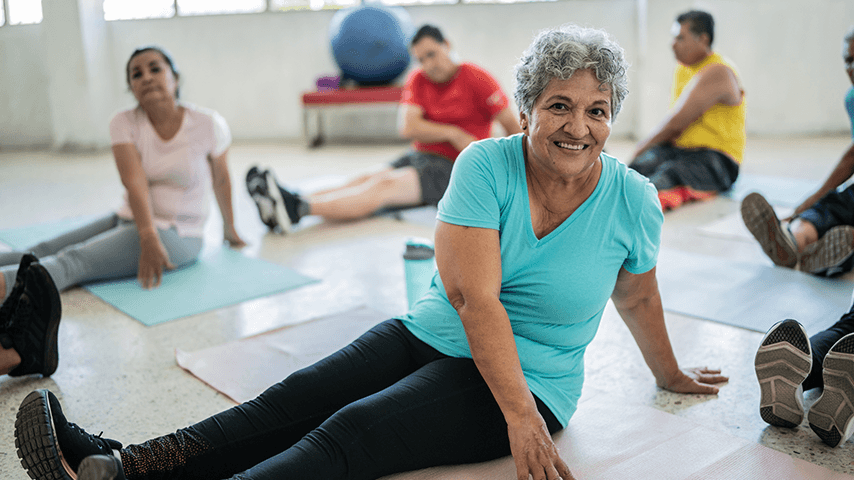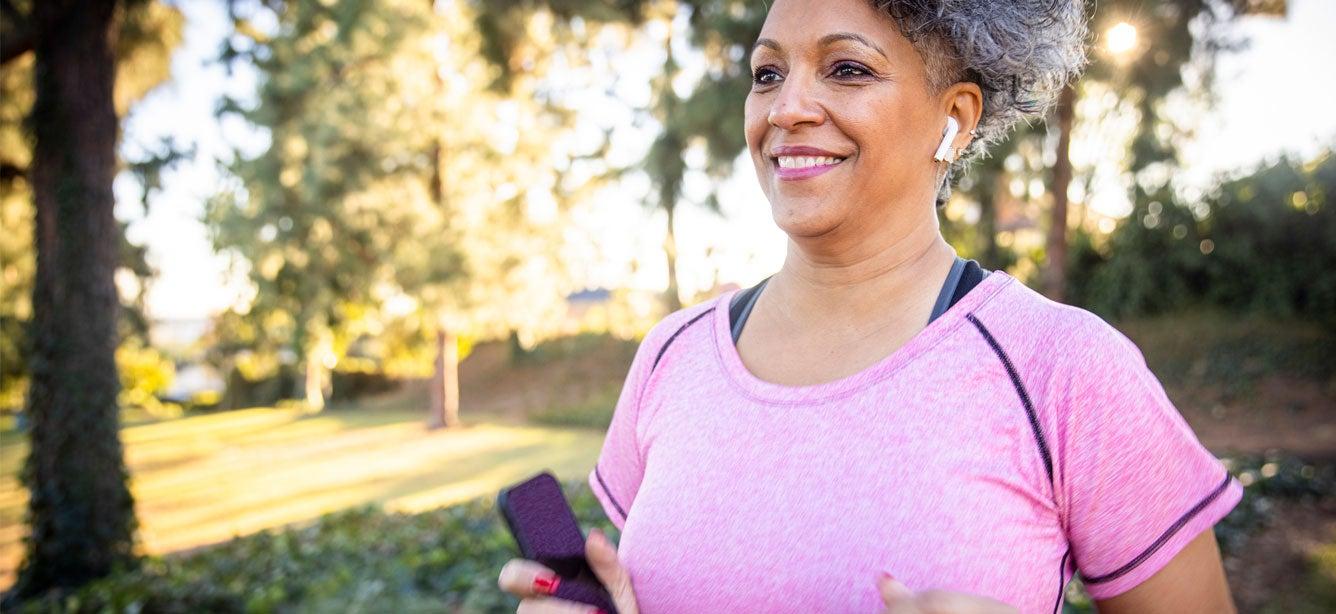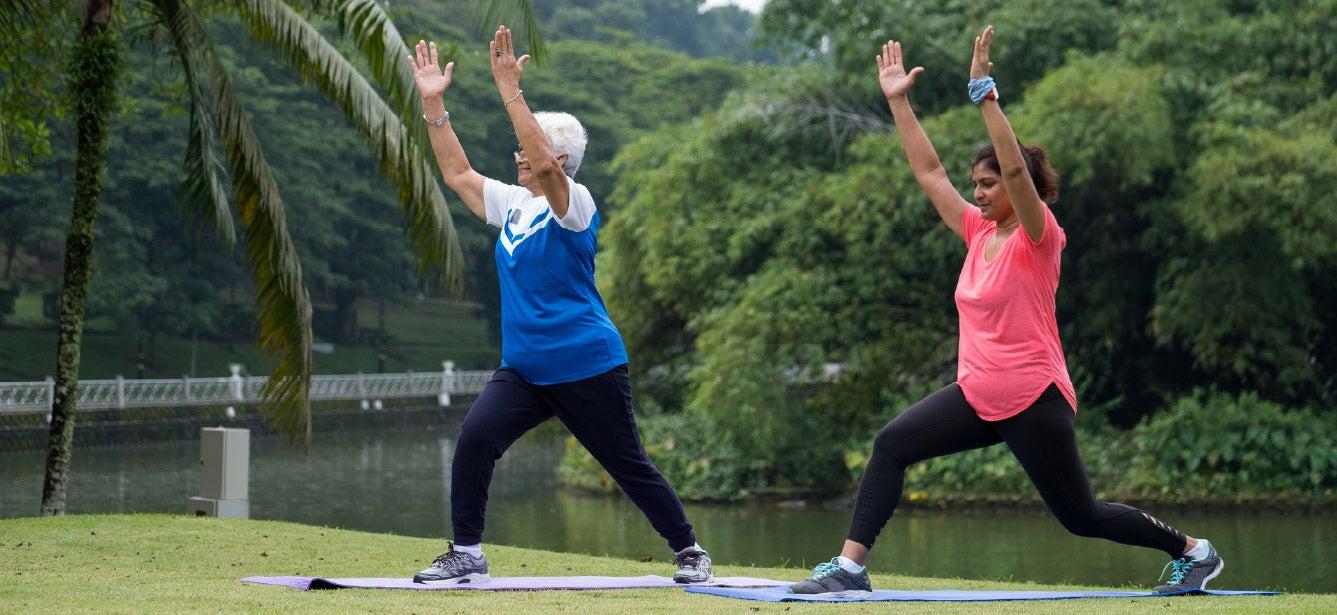
Related Topics
We all can benefit from regular physical activity. But how much? How often? What type? Research shows us we don't need to spend hours a day exercising to reap some benefits.
What are the physical activity guidelines for older adults?
In 2018, the World Health Organization (WHO) published guidelines for adults of all ages to provide a better understanding of what type and how much exercise provides the best health benefits. Updated in 2020, the guidelines recommend adults engage in 150-300 minutes of moderate intensity physical activity or 75 minutes of high intensity physical activity per week.1 The Centers for Disease Control and Prevention recommends adults 65+ get at least 150 minutes of moderately intense or 75 minutes intense aerobic activity each week, as well as strengthening exercises twice a week and some activities to improve balance.2
The guidelines do not list the type of exercises to do; rather, they recommend the type of exercise should be selected by the individual, including but not limited to forms of recreation, avocation, sport, or even play.
Guidelines and recommendations are built by experts using years of evidence and hundreds of research studies. Sometimes, guidelines are too rigid for everyone to follow, but they can provide a foundation for personalization and flexibility. This is how “Exercise Snacks” came to be. An exercise snack is not defined in any guidelines. Just like referring to food, an exercise snack can be a spontaneous experience, created by someone for taste, ease, and convenience.
Ready for an exercise snack?
Let’s take a few moments to define exercise snacks. And let’s be honest, we are hoping we can build on your interest…or appetite.
Exercise snacks are brief episodes of physical activity that may involve a movement that already occurs in your daily life that is repeated, such as getting up from a chair five times instead of one time, or performed at higher intensity, such as walking up a flight of stairs quickly.
One sit to stand becomes 10…and you’re done with your snack; a casual stroll with a few “fast walks” for 25-30 steps; or even four more times rolling to sit up from bed, lay back down and sit back up again.
Exercise snacks are designed to be easy. There is no equipment to set up, and no movement to learn. They are designed to use movements you are already familiar with, and that you need to do during your daily routine. As you can see, an exercise snack may be more tempting due to convenience, length, and your personal choice, but the benefits of exercise snacks do not stop there.
How to choose an exercise snack
Sometimes it can be easier to watch another episode of a show that you just watched…than to decide “what to watch next.” Sometimes it can be easier to continue snacking on a bag of chips than to stop and make something “real” (a meal) to eat. While these behaviors do not serve to sustain a person in a healthy manner for long term, an exercise snack may feel just as appealing, yet without the guilt!
Barriers of time or convenience may keep us from doing something that we know that we should. Paperwork to organize our finances for tax season, deleting old email messages from our inbox, and car maintenance are three activities that may help us in the long run (like healthy movement), yet the time to set up an appointment may keep us from doing the necessary work.
When we participate in an exercise snack, we experience convenience, satisfaction, and personalization (my choice) that can keep us reaching for another “handful.” For example, imagine the convenience of a bowl of healthy nuts that are out on a table. You are not hungry, but you take a small handful anyway. Why? Because it's convenient. Imagine if you could apply that principle to exercise, an activity that is accessible right here and right now. You have to walk from your bedroom to the kitchen, and so you walk fast. Maybe you even repeat that movement. It’s convenient, nothing out of the way, and you now experience the satisfaction of having incorporated exercise into your day.
Exercise snacks are your choice. You should experience the same sense of autonomy with a snack that you get when you choose what you want at a restaurant, and better yet, how we want it prepared. When you finish an exercise snack that you built and completed, you are in control.
Recent research has demonstrated that exercise snacks can add up to significant health gains when placed in our workplace, daily mobility, commute, or errands.3,4 These studies evaluated activities such as taking a flight of stairs quickly, walking briskly most of the way to the bus or mailbox, or even hustling down one specific hallway in your home on the occasion to travel down this route.
So, the next time your body is hungry for more physical activity—or even before it recognizes the hunger—feed it an exercise snack.
Sources
1. World Health Organization. WHO Guidelines on Physical Activity and Sedentary Behaviour. 2020. Found on the internet at https://iris.who.int/bitstream/handle/10665/336656/9789240015128-eng.pdf
2. Centers for Disease Control and Prevention. Older Adult Activity: An Overview. Found on the internet at https://www.cdc.gov/physical-activity-basics/guidelines/older-adults.html
3. Hashim Islam, et al. Exercise Snacks: A Novel Strategy to Improve Cardiometabolic Health. Exercise and Sports Science Reviews. January 2022. Found on the internet at https://pubmed.ncbi.nlm.nih.gov/34669625/
4. Matthew D. Jones, et al. Exercise Snacks and Other Forms of Intermittent Physical Activity for Improving Health in Adults and Older Adults. Sports Medicine. April 2024. Found on the internet at https://link.springer.com/article/10.1007/s40279-023-01983-1




